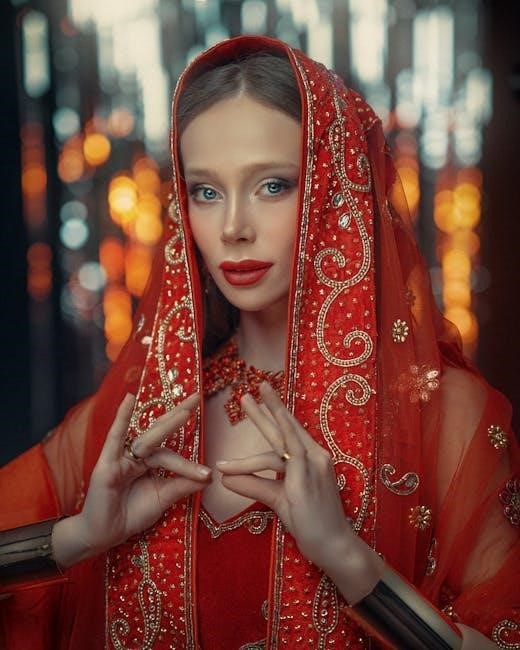Jewelry is a timeless blend of artistry and craftsmanship, transcending mere decoration. It reflects personal style, celebrates milestones, and carries cultural or symbolic meanings. A guide helps navigate its diverse world.
What is Jewelry?
Jewelry is a decorative item worn for personal adornment, expressing identity, status, or cultural heritage. It combines artistic design with craftsmanship, using metals, gemstones, and other materials. Beyond aesthetics, jewelry often carries symbolic or emotional value, marking milestones or traditions. A guide to jewelry helps explore its diversity, from everyday accessories to heirloom pieces, offering insights into its craftsmanship, styles, and significance.

The History of Jewelry
Jewelry has been a part of human culture for over 100,000 years, evolving from primitive beads and shells to intricate designs. Early civilizations used natural materials like bones, stones, and metals to create symbolic pieces. Over time, jewelry transitioned from functional items to decorative art, reflecting status, spirituality, and wealth. Historical periods, such as ancient Egypt and the Renaissance, shaped diverse styles, blending craftsmanship with cultural influences.
The Cultural Significance of Jewelry
Jewelry holds profound cultural and symbolic meaning, often reflecting a wearer’s identity, status, and values. Across civilizations, it symbolizes spirituality, love, and mourning. From traditional adornments to modern designs, jewelry bridges generations, preserving heritage and storytelling. Its universal appeal lies in its ability to convey emotions and connect people through shared traditions and aesthetic expressions.

Understanding Jewelry Basics
Understanding jewelry basics involves knowing the fundamental elements—types, metals, gemstones, and settings—that define its craftsmanship and personal style.
Types of Jewelry: Rings, Necklaces, Earrings, Bracelets
Jewelry comes in various forms, each serving unique purposes. Rings symbolize commitment or personal style, while necklaces add elegance or bold statements. Earrings frame the face, enhancing beauty, and bracelets offer a delicate or dramatic touch. These categories cater to diverse tastes and occasions, making jewelry a versatile accessory for self-expression and celebration.
Metals Used in Jewelry: Gold, Silver, Platinum, Titanium
Jewelry is crafted from various metals, each with unique qualities. Gold is prized for its durability and timeless appeal, available in white, yellow, and rose varieties. Silver offers a sleek, modern look but may tarnish. Platinum is rare and strong, perfect for engagement rings. Titanium is lightweight, hypoallergenic, and ideal for contemporary designs. These metals cater to different styles, preferences, and budgets, making jewelry versatile and accessible.
Gemstones: Diamonds, Pearls, Rubies, Sapphires
Gemstones are the heart of jewelry, offering timeless beauty and symbolic meaning. Diamonds, known for their brilliance and fire, are graded by the 4Cs—carat, color, clarity, and cut. Pearls, with their lustrous glow, are treasured for their natural elegance. Rubies symbolize passion and durability, while sapphires, available in various colors, represent strength and wisdom. Each gemstone carries unique charm, making them indispensable in jewelry design and personal expression.
Jewelry Settings: Prong, Bezel, Pave, Channel
Jewelry settings enhance gemstones’ beauty and durability. Prong settings, with metal claws, secure stones while maximizing light exposure. Bezel settings encase gems in a metal rim, offering a modern, protective look. Pave settings feature small gems held by tiny beads or prongs, creating a diamond-paved effect. Channel settings mount stones in a metal channel, ideal for sleek, eternity bands. Each setting style caters to different tastes and preferences, ensuring a perfect fit for any design.
The 4Cs of Diamonds
The 4Cs—Carat, Color, Clarity, and Cut—define a diamond’s value. Carat is weight, Color grades whiteness, Clarity measures purity, and Cut determines brilliance. Understanding these elements helps in selecting the perfect diamond.
Carat: Understanding Diamond Weight
Carat measures a diamond’s weight, not size. One carat equals 0.2 grams or 200 milligrams. Diamonds are divided into hundredths of a carat, called points. Larger diamonds are rare, making them more valuable. Price increases exponentially with carat weight. Balancing carat with cut and quality ensures brilliance and fire, guiding buyers to the perfect diamond for their budget and preferences.
Color: Grading Diamond Color
Color is graded on a scale from D (colorless) to Z (light yellow or brown). The closer to colorless, the rarer and more valuable the diamond. Subtle differences in color are often hard to detect without professional grading. Colorless diamonds (D-F) are prized for brilliance, while lower grades may offer affordability. Consider your budget and the setting when selecting, as some metals enhance or mask color.
Clarity: Evaluating Diamond Purity
Clarity refers to the presence or absence of inclusions and blemishes in a diamond. Graded by organizations like GIA or AGS, clarity ranges from Flawless (FL) to Included (I). Inclusions are internal imperfections, while blemishes are external. Higher clarity diamonds are rarer and more valuable, but minor inclusions may not affect beauty. Consider your budget and how visible flaws are to the naked eye when selecting.
Cut: The Importance of Diamond Proportions
Cut determines how a diamond refracts light, affecting its brilliance and fire. A well-cut diamond maximizes light performance, while a poor cut reduces sparkle. Graded from Excellent to Poor, cut is crucial for value and beauty. Factors like proportions, symmetry, and polish influence the grade. A precise cut enhances a diamond’s appeal, making it a critical factor in selecting a stunning gemstone.

Jewelry Buying Guide

Buying jewelry involves knowing the basics, setting a budget, and ensuring quality. Understanding craftsmanship helps make the right choice, ensuring pieces align with your personal style.
How to Choose the Right Jewelry Style
Choosing the right jewelry style involves considering personal preferences, lifestyle, and occasions. Reflect on your wardrobe and existing pieces to ensure cohesion. Consider face shape, skin tone, and body proportions for flattering designs. Think about daily wear versus special occasions to select practical yet stylish options. Balance trends with timeless classics to create a versatile collection that enhances your unique aesthetic and budget.
Setting a Budget for Jewelry
Setting a budget for jewelry involves balancing quality, design, and affordability. Determine the occasion—everyday wear or a special event—and prioritize needs over wants. Allocate funds based on durability and personal value, considering metals, gemstones, and craftsmanship. Research price ranges and compare options to find pieces that align with your financial goals. A budget ensures thoughtful, satisfying purchases without compromising on style or quality.
Understanding Jewelry Quality and Craftsmanship
Understanding jewelry quality involves evaluating materials, construction, and attention to detail. High-quality pieces use durable metals and genuine gemstones, while craftsmanship ensures longevity. Look for secure settings, polished finishes, and precise detailing. Well-made jewelry withstands wear and tear, offering long-term value. Assessing these factors helps distinguish between mass-produced items and expertly crafted, timeless pieces that justify their investment.
Tips for Buying Jewelry as a Gift
When buying jewelry as a gift, consider the recipient’s personal style and preferences. Set a budget and seek expert advice for special occasions. Ensure the piece is well-crafted and accompanied by care instructions. A gift box or insurance adds value. Research the brand’s return and exchange policies. For meaningful gifts, opt for timeless designs or custom pieces. Detailed guides can help you make informed decisions and ensure satisfaction.

Jewelry Care and Maintenance
Proper care ensures jewelry lasts. Clean with mild soap, store separately, avoid harsh chemicals, and inspect regularly. Professional maintenance can restore brilliance and extend lifespan.
How to Clean Jewelry at Home
Cleaning jewelry at home is simple. Use a mild soap solution with warm water, gently scrub with a soft brush, and rinse thoroughly. Avoid harsh chemicals, especially for gemstones or pearls. For metal pieces, a polishing cloth can restore shine. Dry thoroughly to prevent tarnish. Regular cleaning maintains brilliance and prevents damage. For intricate designs, professional cleaning is recommended to ensure longevity and preserve craftsmanship.
Storing Jewelry Properly
Proper jewelry storage maintains its beauty and longevity. Store pieces separately in a cool, dry place to prevent scratching. Use protective pouches or boxes with compartments to avoid tangling and damage. Avoid direct sunlight, as it can fade gemstones. Extreme temperatures and humidity can harm certain materials. Clean jewelry before storing to prevent tarnish or corrosion. Regularly inspect stored items to ensure they remain in pristine condition.
Repairing and Maintaining Jewelry
Regular maintenance ensures jewelry lasts for generations. Inspect pieces for loose stones or worn prongs and address issues promptly. Avoid exposing jewelry to harsh chemicals or extreme conditions. For maintenance, use mild detergents and soft cloths to clean. Store items separately to prevent scratching. Professional inspections every few years can catch potential issues early. Proper care preserves both the beauty and value of your treasured jewelry.
Popular Jewelry Styles and Trends
Jewelry trends blend timeless elegance with modern flair, featuring bold statements, minimalist designs, and vintage inspirations. Sustainable materials and custom pieces are increasingly popular, reflecting personal style.
Modern vs. Vintage Jewelry Styles
Modern jewelry often features sleek, minimalist designs with innovative materials, emphasizing simplicity and contemporary aesthetics. Vintage styles, however, draw inspiration from past eras, showcasing intricate details and ornate craftsmanship. While modern pieces appeal to those seeking understated elegance, vintage jewelry captivates with its timeless charm and historical significance, offering a choice between cutting-edge design and classic sophistication.
Trendy Jewelry Pieces to Consider
Trendy jewelry pieces often include lab-grown diamonds, minimalist designs, and layered necklaces. Bold earrings, chunky chains, and delicate anklets are also popular. Sustainable materials and vintage-inspired designs are gaining traction, offering a blend of modernity and timeless appeal. These pieces allow wearers to stay fashionable while expressing their personal style, making them must-consider options for any jewelry collection.
Seasonal Jewelry Trends
Seasonal jewelry trends offer fresh inspiration, with designs reflecting the spirit of each time of year. For winter, icy blues and metallics shine, while summer favors bright, beach-inspired pieces. Spring blooms with floral motifs, and autumn highlights warm, earthy tones. Holiday collections, like Valentine’s Day heart motifs or Christmas sparkle, add festive flair. These trends allow jewelry lovers to refresh their wardrobes and celebrate the uniqueness of every season.

Engagement and Wedding Jewelry
Engagement and wedding jewelry symbolizes eternal commitment, with timeless designs like solitaire diamonds and classic bands. Explore styles, options, and personalized touches to make these pieces truly unforgettable.
Choosing the Perfect Engagement Ring
Selecting the perfect engagement ring involves understanding the 4Cs: carat, color, clarity, and cut. Consider her style—classic, modern, or vintage—and her ring size. Popular settings include solitaire, halo, and pave. Metals like gold, platinum, or titanium vary in durability and appearance. Budget is crucial; allocate wisely across diamond quality and setting. Personalize with engravings or gemstones for a unique touch. Expert guidance can help finalize the decision.
Wedding Bands: Styles and Options
Wedding bands come in various styles to suit every preference. Classic options include plain gold, silver, or platinum bands, while modern designs feature intricate details or textured finishes. Vintage styles often incorporate engravings or milgrain accents. Consider metals like titanium for durability or rose gold for a romantic touch. Settings like prong, bezel, or channel can enhance the band’s appearance. Personalize with engravings or gemstones for a unique, meaningful piece.
Jewelry for Bridesmaids and Groomsmen
Jewelry for bridesmaids and groomsmen adds a touch of unity and elegance to the wedding party. Bridesmaids often wear matching earrings, necklaces, or bracelets, while groomsmen may don cufflinks or tie bars. Personalized pieces, such as engraved cufflinks or birthstone jewelry, make thoughtful gifts. Consider durable metals like titanium or stainless steel for long-lasting keepsakes. Coordinating styles ensure a cohesive look, celebrating the special bond of the wedding party.
The History of Jewelry
Jewelry has adorned humans for over 100,000 years, starting with primitive materials like stones and bones. Ancient civilizations refined techniques, using metals and gemstones, symbolizing status and spirituality.
Ancient Civilizations and Jewelry
Ancient jewelry dates back over 100,000 years, with early pieces crafted from stones, bones, and natural materials. Civilizations like Egypt, Mesopotamia, and the Indus Valley used gold, gemstones, and beads, often symbolizing status, spirituality, or power. Egyptian jewelry featured intricate designs with lapis lazuli and carnelian, while other cultures incorporated shells and metals, laying the foundation for modern jewelry-making traditions.
Jewelry in Different Cultures
Jewelry holds significant cultural and symbolic meaning worldwide. From Native American turquoise pieces to African beadwork, each culture crafts jewelry reflecting its heritage. Indian jewelry often features intricate gold and gemstones, symbolizing status and spirituality. Similarly, African cultures use beads and cowry shells for rituals and adornment. These diverse traditions highlight jewelry’s universal role in expressing identity, spirituality, and cultural values across civilizations.
Evolution of Jewelry Design
Jewelry design has evolved significantly over centuries, reflecting changing tastes and techniques. Ancient civilizations favored natural materials like beads and metals, while the Middle Ages saw intricate religious motifs. The Renaissance brought ornate goldwork, and Art Nouveau introduced flowing organic designs. Modern jewelry embraces minimalism, lab-grown diamonds, and sustainable practices, blending tradition with innovation to meet contemporary styles and ethical standards.
Custom Jewelry
Custom jewelry allows personalization, transforming ideas into unique pieces. Collaborate with jewelers to craft designs that reflect individual style, ensuring a truly one-of-a-kind creation.
Designing Your Own Jewelry
Designing custom jewelry involves transforming personal ideas into wearable art. Start by sketching concepts or using digital tools to visualize designs. Collaborate with a jeweler to refine details like metal type, gemstones, and settings. Consider lifestyle and preferences to ensure practicality and comfort. This creative process allows for a piece that reflects individuality and tells a unique story, making it truly special and meaningful.
Working with a Jeweler
Collaborating with a professional jeweler ensures your vision becomes reality. Share your ideas, budget, and preferences to guide the design process. A skilled jeweler can recommend metals, gemstones, and settings that suit your lifestyle. Don’t hesitate to ask questions or request modifications. Clear communication and trust are key to creating a piece that meets your expectations and holds lasting value.

Cost Considerations for Custom Pieces
Custom jewelry costs vary based on materials, design complexity, and craftsmanship. Metals like gold and platinum are pricier than silver or titanium. Gemstones, especially high-quality diamonds or rare stones, significantly impact the price. Intricate designs require more labor, increasing costs. Discuss your budget with the jeweler to balance aesthetics and affordability. Additional fees for engraving or resizing may apply, so plan accordingly for your custom piece.
Jewelry is a timeless expression of style and sentiment. For further learning, explore resources like “The Jewelry Guide: The Ultimate Compendium” and online platforms such as Stuller.com, offering detailed insights and expert tips for enthusiasts and professionals alike.
Final Thoughts on Jewelry
Jewelry is a timeless expression of personal style, emotion, and cultural heritage. Whether for celebration, self-expression, or investment, it holds enduring appeal. Consider quality, craftsmanship, and meaningful designs when selecting pieces. Resources like “The Jewelry Guide: The Ultimate Compendium” offer deeper insights, ensuring informed choices for enthusiasts and collectors alike.
Recommended Reading and Resources
For deeper insights, explore “The Jewelry Guide: The Ultimate Compendium” by Fabienne Reybaud, covering history and techniques. Visit Stuller.com for industry basics and gemstone education. Lab-grown diamond guides from VRAI and styling tips from Vogue offer modern perspectives. These resources provide a comprehensive understanding, helping enthusiasts and buyers make informed decisions in the world of jewelry.
